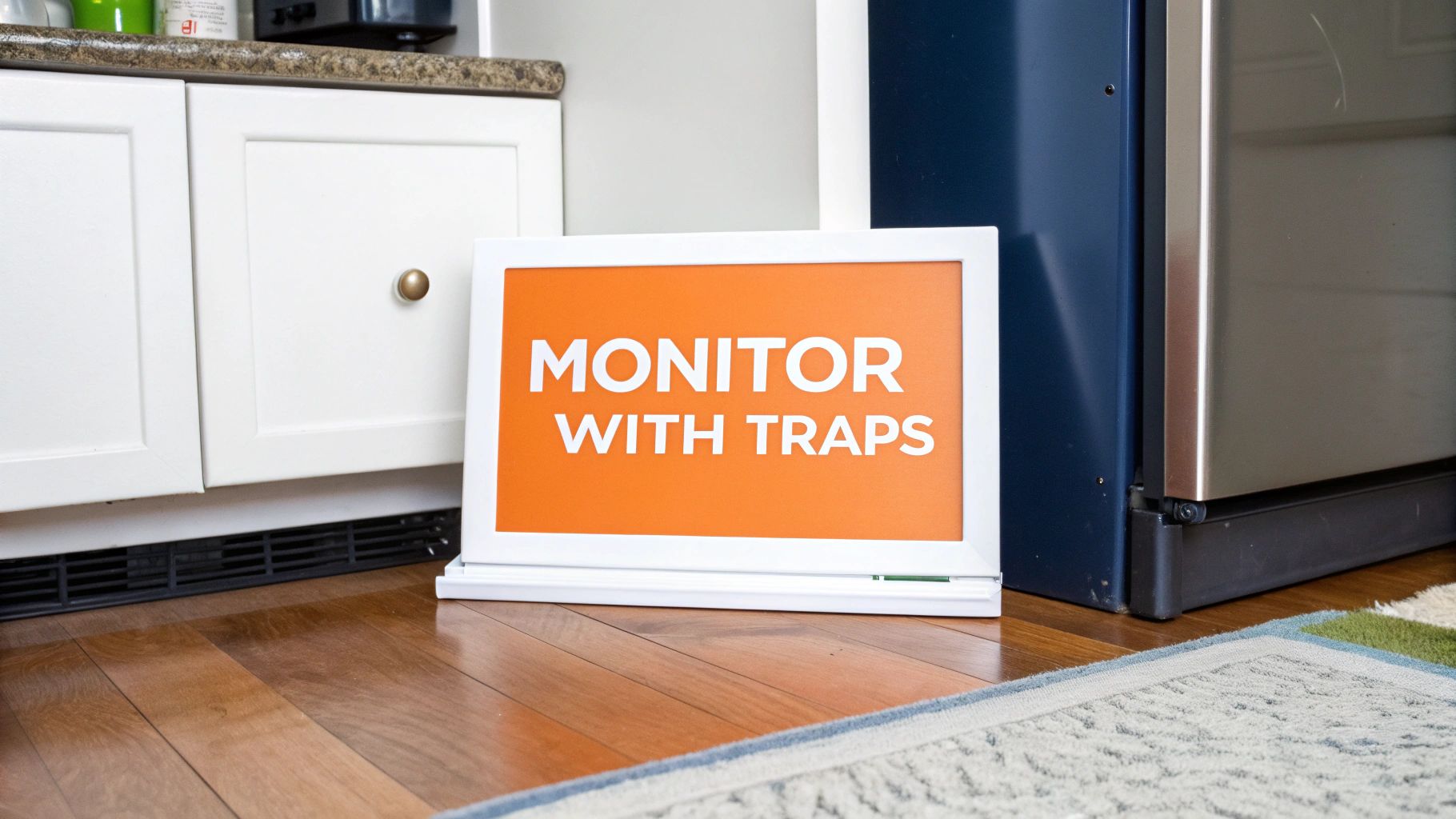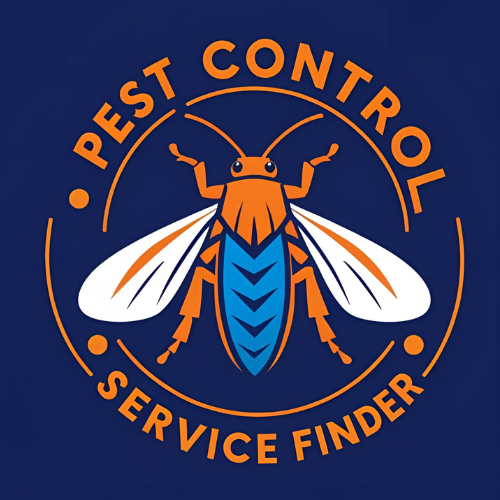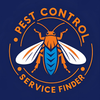How to Prevent Roaches in Your Home for Good

Roaches only infest dirty homes. This is a common myth. Roaches are survivors. They seek water, food, and shelter. Even the cleanest homes can have them. A good plan is the best defense.
The real trick isn't just cleaning. It's about outsmarting them. It's about making your home unlivable for them. If you need immediate help with this, Call +1 855 224 3071 for expert advice.
It’s Not About How Clean Your Home Is
So many people I talk to believe that if their home is sparkling clean, they're immune to cockroaches. While good sanitation is definitely a huge piece of the puzzle, it’s not the whole story. These pests have been around for millions of years, and they're driven by instincts far more basic than just finding a few crumbs.
To really get ahead of them, you have to understand what they're actually looking for.
- Water: Even a tiny drip from a pipe under the sink or a damp rug on the bathroom floor is like a five-star resort for a thirsty roach.
- Shelter: That stack of cardboard boxes in the garage? The pile of mail you've been meaning to sort? Those are perfect hiding spots and breeding grounds.
- Food: Sure, they love leftover pizza, but they're not picky. They’ll happily munch on soap, the glue in bookbindings, and even wallpaper paste.
If you're seeing roaches despite keeping your place tidy, it’s a red flag. It means you need to look past the surface and start cutting off their access to these basic survival needs. For immediate, expert advice on your home's specific risks, you can Call +1 855 224 3071 for a professional consultation.
The Original Global Hitchhiker
Part of their incredible resilience comes from how long they've been our unwanted roommates. The German cockroach, one of the most common invaders we deal with, has been traveling with humans for thousands of years.
Believe it or not, scientists traced its origins back to Asia around 2,100 years ago. From there, it spread across the entire globe by hitching rides on our trade and migration routes. Today, this single species is found on every continent except Antarctica—a stunning testament to its adaptability. You can actually learn more about their global journey here if you're curious.
This history just proves one thing: roaches are experts at finding their way into our homes, no matter how well we clean. If you're fighting a losing battle, professional help is just a phone call away. Call +1 855 224 3071 to connect with a local expert who knows exactly what to do.
Sealing Your Home Against Roach Intruders
Most people think preventing roaches starts and ends with cleaning. While keeping a tidy home is a huge piece of the puzzle, the most powerful thing you can do is become a pest security expert for your own house. It's all about creating a physical barrier they can't get past.
Roaches are escape artists. A German cockroach, one of the most common invaders, can squeeze its body through a crack no thicker than a dime. This means you have to get serious about hunting down and sealing every single potential entry point. You're basically turning your home into a fortress.
This infographic really drives home why they invade in the first place, and it’s not always about a messy kitchen.

As you can see, the biggest draws are simply moisture and shelter—things that can exist even in the cleanest of homes.
Your Roach-Proofing Checklist
To really win this battle, you have to start thinking like a roach. They’re looking for dark, hidden pathways from the outside into places with food and water. Your job is to find and block these highways.
Kitchen and Bathroom Hotspots:
- Under the Sink: This is ground zero. Check where plumbing pipes come through the wall. Those big, ugly gaps are a welcome mat for pests. My go-to trick is to stuff coarse steel wool in the gap first (they can’t chew through it), then seal over it with caulk.
- Behind Appliances: When was the last time you looked behind your fridge or stove? Pull them out. You'll almost certainly find gaps around water lines or electrical wires that need a good bead of flexible caulk.
- Cabinet and Drawer Gaps: Look deep into the back corners of your cabinets. Installers sometimes leave small gaps or unfinished holes that serve as perfect, hidden entry points.
If you find gaps that are too big or complicated to tackle yourself, don't just leave them. Call +1 855 224 3071 and we'll connect you with local pros who specialize in this kind of exclusion work.
Expanding Your Search Perimeter
Roaches don't just use the front door. To truly seal your home, you need to look at the entire exterior shell. This is what separates a temporary fix from a long-term solution.
Take a slow walk around the outside of your house. Zero in on the foundation and look for any small cracks. Check where siding meets the concrete. A tube of weather-resistant silicone caulk is your best friend here.
A tiny rip in a window screen might seem like no big deal, but to a roach, it's an open invitation. This is one of the most overlooked entry points I see in homes.
Even a small tear is a problem, so learning how to repair window screen is a critical homeowner skill. While you're at it, check the weather stripping around your doors and windows. If it's worn out, it creates an easy path for pests to slip right in.
Putting in the time to methodically seal up these vulnerabilities is the single most effective roach prevention strategy. You’re not just cleaning up; you’re locking them out for good. If the job feels like too much, professional help is ready. For a fast connection to local experts, Call +1 855 224 3071 and get your home secured.
Your Guide to Roach-Proof Home Sanitation
You might think a spotless home is a roach-free home, but wiping down counters just isn’t enough. True roach prevention means you have to start thinking like a roach and get rid of what they need to survive.
To a roach, a "clean" home is one with zero food, zero water, and nowhere to hide. This level of sanitation goes way beyond surface cleaning. It’s about turning your daily routines into a powerful defense against these nasty intruders.

Eliminating Hidden Food Sources
The first rule of roach-proofing is cutting off their food supply—completely. Roaches are shameless scavengers that will eat just about anything, so you have to be relentless. This is about more than just sweeping up a few crumbs.
It means getting into the habit of deep cleaning those forgotten zones where grease and food bits build up. Make a point to pull out your refrigerator and stove at least once a month. I guarantee you’ll be shocked by the grime and dropped food back there. For roaches, it’s a five-star buffet.
How you store your food is just as important. Cardboard boxes and flimsy plastic bags are an open invitation for a hungry roach.
- Pantry Goods: The minute you get home from the store, transfer things like cereal, pasta, flour, and sugar into airtight glass or hard plastic containers.
- Pet Food: Never leave pet food bowls out overnight. Store the kibble in a sealed container, not the paper bag it came in.
- Trash Cans: Always use a trash can with a tight-fitting lid and take it out every single night, especially if it has food scraps in it.
If you’re doing all this and still struggling, our guide on what attracts roaches to your home offers even more detailed insights. When your best efforts aren't enough, it's time for an expert evaluation. Call +1 855 224 3071 to get connected.
Cutting Off Their Water Supply
Here’s a fact that surprises most people: water is even more critical to a roach than food. Most species can live a month without eating, but only about a week without water. This makes getting rid of moisture one of your most powerful prevention tactics.
Start by fixing any leaky faucets or pipes, no matter how small that drip seems. Check under every sink for any signs of moisture and get those issues repaired fast. After you do dishes or take a shower, take a second to wipe the sink and tub dry.
Don't forget to check the hidden water sources. The drip tray under your refrigerator and condensation on pipes are common hydration stations for roaches that most homeowners completely miss.
Even a damp sponge left in the sink or a wet bathmat on the floor is a welcome oasis for them. By making your home a desert, you make it a place they can't survive.
To keep these tasks manageable, it helps to break them down into a simple routine.
Daily vs Weekly Roach Prevention Checklist
This checklist isn't about adding a ton of work to your plate. It's about integrating small, powerful habits into your existing cleaning schedule to make your home consistently unattractive to roaches.
| Task | Frequency | Why It Matters |
|---|---|---|
| Wipe down kitchen counters and stovetop | Daily | Removes grease and food crumbs they feast on overnight. |
| Sweep or vacuum kitchen floor | Daily | Eliminates tiny food particles that attract scouts. |
| Wash dishes immediately; don't leave in sink | Daily | Removes a primary food and water source. |
| Take out the trash (especially with food scraps) | Daily | Prevents odors that draw roaches from far away. |
| Wipe sinks and tubs dry | Daily | Cuts off their most critical resource: water. |
| Deep clean under and behind appliances | Weekly | Removes hidden grease and food buildup in their favorite spots. |
| Mop floors with a cleaning solution | Weekly | Eliminates sticky spills and food residue mopping misses. |
| Check under sinks for leaks or moisture | Weekly | Catches plumbing issues before they become a roach water park. |
| Declutter paper, cardboard, and old boxes | Weekly | Gets rid of their preferred hiding and breeding grounds. |
Sticking to a simple schedule like this turns your home into a fortress. It's consistency, not intensity, that wins the war against roaches.
Removing Their Favorite Hiding Spots
Finally, sanitation means decluttering. Roaches crave dark, tight spaces where they can hide out and breed without being disturbed. Their absolute favorite materials are paper and cardboard because they hold onto pheromones that signal to other roaches that it’s a safe place to hang out.
Get rid of those stacks of old newspapers, magazines, and cardboard boxes in your home, garage, and basement. All that clutter is prime real estate for roaches. And where they hide, they bring germs.
In fact, research shows they are incredibly effective carriers of parasites and pathogens. One study found that 46.4% of captured cockroaches carried parasitic organisms on their bodies that can cause serious illnesses. You can read the full research about these health risks to see just how serious it is. If that makes you want to act right now, Call +1 855 224 3071 to connect with a pest control expert today.
Using Traps and Baits for Early Detection
Most people think roach traps are just for killing roaches after you already have a problem. That’s a common mistake. The real power of traps isn't about killing bugs—it's about gathering intel.
Even if your home is spotless and sealed up tight, a random roach can still wander in from outside or a neighbor's apartment. Using traps is how you catch that one scout before it calls in the rest of its colony.
Simple sticky traps are your best friend here. They're cheap, safe to use around kids and pets, and they give you a clear picture of what's happening when you're not looking. The trick is knowing where to put them.

Strategic Trap Placement
Roaches are predictable. They stick to the shadows, love moisture, and travel along the same hidden paths every night. Think of these as "roach highways." Placing your traps along these routes is what makes them so effective. It tells you exactly where to focus your efforts.
Here are the absolute best spots for your little monitoring stations:
- Under Sinks: Kitchen and bathroom sinks are ground zero for roaches because of the constant moisture.
- Behind the Fridge: It's warm, dark, and often has condensation. Basically, it's a roach paradise.
- Back Corners of Cabinets: Pay special attention to lower cabinets, especially those with food or plumbing lines running through them.
- Near the Water Heater: This is another classic hideout—it’s warm, dark, and nobody ever bothers it.
Get in the habit of checking these traps once a week. If you catch a single roach, don't panic. It’s just a heads-up to go back and double-check your cleaning and sealing in that specific spot.
But if you start seeing several roaches? That’s a clear sign you're dealing with something more than just a lone wanderer. For immediate professional guidance, Call +1 855 224 3071 to get an expert assessment of the situation.
Safe and Simple DIY Baits
While your traps are doing surveillance, you can use simple, non-toxic baits to knock out any scouts that come exploring. These aren't strong enough to handle a real infestation, but they work great for picking off the early arrivals. The best part? You probably already have the ingredients in your kitchen.
A classic, effective DIY bait is a mix of baking soda and powdered sugar in equal parts. The sugar draws them in, and the baking soda does the rest. It causes a reaction in their digestive system that’s lethal to them but harmless to your family and pets.
Just put this mixture in a few bottle caps or small, shallow lids. Slide them into the same sneaky spots where you put your traps—under the sink, behind appliances, and so on. This keeps it out of reach of curious pets and toddlers while putting it right in the roaches' path.
Diatomaceous earth (DE) is another fantastic, safe option. It’s a natural powder that feels like dust to us but is like sharp, microscopic glass to an insect. It gets on their exoskeleton and dehydrates them. For a deeper look at safe alternatives, check out our guide on finding a reliable non-toxic cockroach killer.
Just remember, these DIY methods are for prevention and catching the first signs of trouble. If your traps are filling up regularly or you're seeing roaches during the daytime, you're past the point where DIY will work. That's a sure sign of a hidden infestation.
Don't let it spiral out of control. Call +1 855 224 3071 and get connected with a vetted exterminator immediately.
Knowing When to Call a Pest Control Professional
It's a common trap to think you can solve a roach problem with a can of bug spray from the hardware store. The truth is, that spray might be making your situation much, much worse. When you're up against a pest as tough as a cockroach, knowing when to throw in the towel and call in the pros is the smartest thing you can do.
Sure, DIY methods are fine for dealing with a single, lost roach. But there are unmistakable signs that you're dealing with a full-blown infestation hiding deep inside your walls, far beyond the reach of any store-bought trap. Learning to spot these signals will save you a ton of time, money, and stress.
Red Flags That Demand a Professional
If you notice any of the following, your roach problem is officially bigger than you think. Roaches are nocturnal creatures, so seeing them wandering around in the daylight is a huge warning sign that their hiding spots are completely maxed out.
- Daytime Sightings: Spotting a roach during the day is a bad sign. It usually means the infestation is so huge they're being forced out into the open to find food.
- Roaches in Multiple Rooms: Finding roaches in the kitchen and an upstairs bathroom? That means they've set up multiple nests and are spreading throughout your home's structure.
- Visible Egg Casings (Oothecae): Discovering those small, dark, purse-shaped egg capsules means one thing: the roaches are actively breeding and the population is exploding.
- A Persistent Musty Odor: A large roach infestation creates a distinct, oily, musty smell that only gets stronger as their numbers grow.
If any of these sound familiar, it's time to bring in professional help. For a fast connection to licensed exterminators in your area, Call +1 855 224 3071.
Why Over-the-Counter Sprays Fail
Grabbing that aerosol can feels like you're taking immediate action, but most of those products just scatter the roaches. The "repellent" chemical sends them running deeper into wall voids and other hidden areas, spreading the infestation instead of containing it. This just makes the real problem much harder for a professional to track down and eliminate later. For more on why professional-grade solutions are non-negotiable for certain species, you can learn more about getting rid of German roaches in our detailed guide.
A licensed technician won't just spray and pray. They identify the exact species, hunt down the source of the infestation, and use targeted baits and non-repellent treatments that roaches unknowingly carry back to the nest. This is how you wipe out the entire colony from the inside.
This strategic approach is something DIY products simply can't deliver. Research has shown time and again that integrated pest management—focusing on sanitation and sealing entry points—is the cornerstone of effective prevention, particularly in multi-family housing where one apartment's problem quickly becomes everyone's problem. You can discover more insights about these findings and their impact on modern pest control.
Don't wait for a few roaches to turn into a major health hazard. Making the right call at the right time is the single most effective way to keep roaches from taking over. If you're ready to solve the problem for good, Call +1 855 224 3071 now.
Common Questions About Roach Prevention
Everyone wants a magic spray or a single secret scent that will solve their roach problem for good. It sounds easy, right? Just find the one thing roaches hate and use it everywhere. But here's the reality: roaches have been around for millions of years precisely because they are masters of adaptation, not because they're picky eaters or sensitive to smells.
The real secret to keeping them out has nothing to do with magic bullets. It’s all about a consistent defense built on sanitation, exclusion, and vigilance. Let’s tackle some of the most common questions homeowners have about keeping these pests at bay.
What Smells Actually Keep Roaches Away
Many people hope for a simple, nice-smelling fix, but fragrances are not a reliable strategy for long-term roach prevention. Sure, roaches dislike strong smells from essential oils like peppermint and cedarwood, or even dried bay leaves. These might work as a temporary deterrent in a very small, contained space like a single drawer or cabinet.
The problem is, these scents fade fast and do absolutely nothing to fix the root cause of why roaches are there in the first place. Roaches are hunting for three things: food, water, and shelter. They couldn't care less if your kitchen smells like a pine forest.
The most effective "repellent" you can use is the complete absence of food odors. You achieve that through relentless, consistent cleaning—not by masking smells with something else. Put your energy into sanitation and sealing cracks, not into essential oils.
Can I Get Rid of Roaches On My Own
Yes, you can absolutely handle a small, localized roach sighting yourself. If you’ve only spotted one or two roaches, the methods we’ve covered—deep cleaning, sealing entry points, and using traps to monitor—are often very effective at shutting the problem down before it starts.
But you have to act fast, because roaches multiply at an alarming rate. A German cockroach, one of the most common indoor pests, can produce a whole new generation in about 100 days. A tiny issue can become a full-blown infestation before you know it.
If you start seeing roaches regularly, spotting them during the daytime (a bad sign), or finding them in multiple rooms, the infestation is already far bigger than what you can see. At that point, DIY methods just won't cut it. Professionals have access to targeted treatments that can eliminate the source. If you're not sure how bad it is, Call +1 855 224 3071 to get an expert opinion right away.
How Do Roaches Get Into a Clean Apartment
This is one of the most frustrating situations for apartment dwellers. You can keep your place spotless, but roaches can still show up. Why? Because they treat shared walls, plumbing lines, and electrical conduits like their own personal highway system, traveling easily from one unit to another.
They can also hitch a ride into your home without you ever noticing.
- On grocery bags and cardboard delivery boxes
- Inside used furniture or second-hand electronics
- From an adjoining apartment that has an existing infestation
This is exactly why sealing up your unit is so critical. Caulking gaps around pipes under the sink, along baseboards, and behind outlet covers creates a physical barrier. You should also get in the habit of inspecting everything you bring into your home. If you suspect the problem is building-wide, tell your property manager immediately. A coordinated building effort is the only way to solve a shared infestation.
For a deeper dive into protecting your home, check out an ultimate home defense guide for roach prevention. It offers some great strategies that build on these points. For immediate help, Call +1 855 224 3071.

